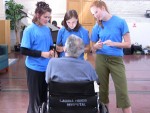Title
Excited, motivated, and armed with a strong program, a team of four dancers (Breanna O’Mara, Troy Macklin, Julia Eichten, and Esmé Boyce), one actor (J. Alex Brinson), and a jazz musician (Kyle Athayde)—all students or very recent graduates from Juilliard—jumped headfirst this summer into an outreach program in the San Francisco Bay area of California, funded by a Juilliard Summer Grant. The objective of our program was to engage diverse artists, audiences, and youth through collaboration, self-produced programming, and arts education.
Body
We aimed to enrich communities of the Bay area who rarely encountered live concert performance by bringing our program to their facilities. Our vision was to create bridges within and between communities through positive artistic exchange. We toured 8 cities, gave 14 public performances, and conducted 27 arts workshops within a two-week period, and Esmé created an original dance work on students at San Ramon Valley Dance Academy, a small dance studio in San Ramon, Calif.
Of these numerous activities, one of the group’s most astonishing and encouraging experiences was our performance at the Federal Correctional Institute, a women’s prison in Dublin. The women were gathered in the bleachers of an outdoor basketball court with an awning. The waning sun lit the far corner of the court and made everything on that portion of the ground glow. With each piece we shared, the audience became more attentive. As we interacted with the audience, it was shocking to realize that these women looked so much like people we might know, yet had histories that had brought them to prison. The space was charged with a focus created by enormous curiosity from the women and our desire to impart as much as we could in such a short time. At the end of the showing, we talked to inmates and shook hands; all were beaming, and some expressed hopes of becoming performers after they finished their time in prison. One woman said she choreographed small dance numbers for women in the prison and that seeing us dance had given her some new ideas. The kindness and encouragement they showed us were amazing.
Another special venue was Thunder Road, an adolescent treatment center in Oakland. We were worried about how to engage what we thought might be a group of troubled, angry teenagers who did not want to be there; what we encountered completely upended our preconceived notions. The teenagers were energetic, insightful, and eager to learn anything we could offer them. As our first performance was underway (we performed for boys and girls separately), it became clear that interactive games and discussions were the way to go. One memorable young man attempted to give Troy directions in jibberish during an acting improvisation game; his inventive humor was apparent as he explained countless hills, curves, and turns with the gesturing arm. (Troy’s attempt to follow these comical directions proved equally funny.) Another audience member offered a title for a trio created and performed by Breanna, Julia, and Esmé. During a discussion, we all agreed he had chosen the perfect name, Rewind—concise, and very evocative of the movement. Working with the female youth at this facility was equally rewarding; comments about our performance included that they saw “energy,” “repetition and variation,” and representations of “inner peace and strength,” all of which were precisely on point and gave us further insight into the works ourselves. The youths at this rehabilitation center greatly appreciated the outlet we provided, and that made the performance a worthwhile, good-for-the-soul experience.
We had many wonderful surprises, including meeting an audience member at Laguna Honda Hospital, a convalescent care center, who had been an ear-training teacher at Juilliard. It was wonderful to see his face light up as we exchanged stories about life at Juilliard now, and how it had been when he was a teacher. He joked about how a few current Juilliard faculty members owe him homework from 20 years ago. We promised to pass on the message.
At the San Ramon Valley Dance Academy, Esmé choreographed a dance for seven of the students enrolled in the program, ranging in age from 13 to 20. The idea was to throw these bright and eager students into a learning experience drastically different from what they were used to. The piece, titled Growing Under Your Thumb: A Flipbook Dance, was based on the idea of taking snapshots of life in order to show how each dancer was growing moment to moment. The dancers were asked to take personal responsibility for their performance quality and include all of themselves when they moved. The performance of the piece was a burst of life that showed renewed curiosity for movement.
Throughout the two weeks, the team was able to touch the lives of diverse groups of people and spread arts awareness and education throughout the Bay area. Our performances, especially at the youth centers, evolved into workshops involving participation by the youth. As we spent time at these facilities, we realized that more than just one visit to these places is needed. It was apparent to each of us that this tour was only the beginning of a larger, lifelong task of making art accessible to all.





